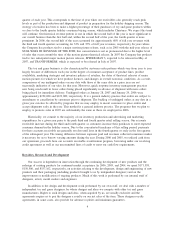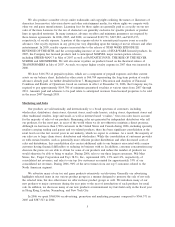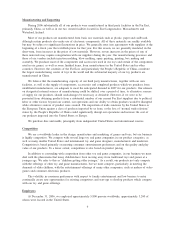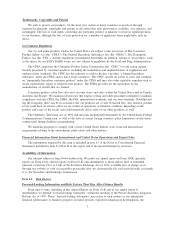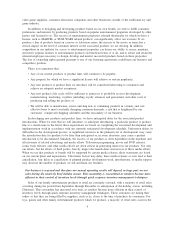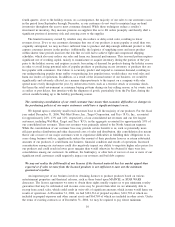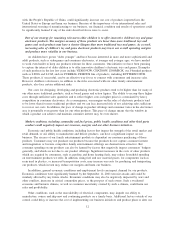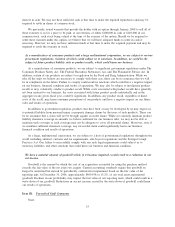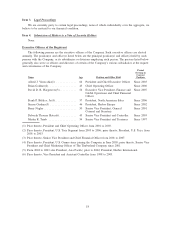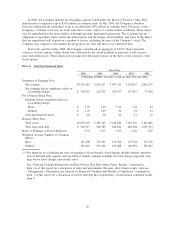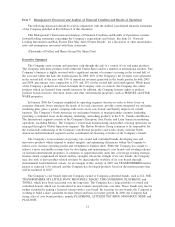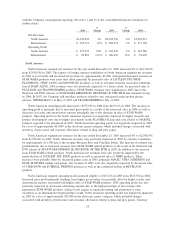Hasbro 2006 Annual Report Download - page 25
Download and view the complete annual report
Please find page 25 of the 2006 Hasbro annual report below. You can navigate through the pages in the report by either clicking on the pages listed below, or by using the keyword search tool below to find specific information within the annual report.We rely on external financing, including our credit facilities and accounts receivable securitization
facility, to fund our operations. If we were unable to obtain or service such financing, or if the
restrictions imposed by such financing were too burdensome, our business would be harmed.
Due to the seasonal nature of our business, in order to meet our working capital needs, particularly those
in the third and fourth quarters, we rely on our revolving credit facility and our other credit facilities for
working capital. We currently have a five-year revolving credit agreement, which provides for a $300,000
committed revolving credit facility which provides the Company the ability to request increases in the
committed facility in additional increments of $50,000, up to a total of $500,000. The credit agreement
contains certain restrictive covenants setting forth leverage and coverage requirements, and certain other
limitations typical of an investment grade facility. These restrictive covenants may limit our future actions, and
financial, operating and strategic flexibility. In addition, our financial covenants were set at the time we
entered into our credit facility. Our performance and financial condition may not meet our original
expectations, causing us to fail to meet such financial covenants. Non-compliance with our debt covenants
could result in us being unable to utilize borrowings under our revolving credit facility and other bank lines, a
circumstance which potentially could occur when operating shortfalls would most require supplementary
borrowings to enable us to continue to fund our operations.
As an additional source of working capital and liquidity, we currently have a $250,000 accounts
receivable securitization program, which is increased to $300,000 from fiscal October through fiscal January.
Under this program, we sell on an ongoing basis, substantially all of our U.S. dollar denominated trade
accounts receivable to a bankruptcy remote special purpose entity. Under this facility, the special purpose
entity is able to sell, on a revolving basis, undivided ownership interests in the eligible receivables to bank
conduits. During the term of the facility, we must maintain certain performance ratios. If we fail to maintain
these ratios, we could be prevented from accessing this cost-effective source of working capital and short-term
financing.
We believe that our cash flow from operations, together with our cash on hand and access to existing
credit facilities and our accounts receivable securitization facility, are adequate for current and planned needs
in 2007. However, our actual experience may differ from these expectations. Factors that may lead to a
difference include, but are not limited to, the matters discussed herein, as well as future events that might have
the effect of reducing our available cash balance, such as unexpected material operating losses or increased
capital or other expenditures, as well as increases in inventory or accounts receivable that are ineligible for
sale under our securitization facility, or future events that may reduce or eliminate the availability of external
financial resources.
We also may choose to finance our capital needs, from time to time, through the issuance of debt
securities. Our ability to issue such securities on satisfactory terms, if at all, will depend on the state of our
business and financial condition, any ratings issued by major credit rating agencies, market interest rates, and
the overall condition of the financial and credit markets at the time of the offering. The condition of the credit
markets and prevailing interest rates have fluctuated in the past and are likely to fluctuate in the future.
Variations in these factors could make it difficult for us to sell debt securities or require us to offer higher
interest rates in order to sell new debt securities. The failure to receive financing on desirable terms, or at all,
could damage our ability to support our future operations or capital needs or engage in other business
activities.
As of December 31, 2006, we had $494,983 of total principal amount of indebtedness outstanding. If we
are unable to generate sufficient available cash flow to service our outstanding debt we would need to
refinance such debt or face default. There is no guarantee that we would be able to refinance debt on favorable
terms, or at all. This total indebtedness includes $249,996 in aggregate principal amount of 2.75% senior
convertible debentures that we issued in 2001. On December 1, 2011 and December 1, 2016, and upon the
occurrence of certain fundamental corporate changes, holders of the 2.75% senior convertible debentures may
require us to purchase their debentures. At that time, the purchase price may be paid in cash, shares of
common stock or a combination of the two, at our discretion, provided that we will pay accrued and unpaid
14


